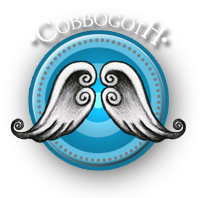Alright, now on to outlining. I'm a firm believer of outlining. I don't know if it's my dyslexia, which makes it very difficult for me to hold a lengthy story plot in my head all at once, or what, but I've tried to write a novel with and without an outline, and I far prefer with.
So, I thought I'd write a little post and tell you all how I like to outline. It's a pretty simple process I like to call "Outlining in Parts." I've done this with all seven books in the Cobbogoth series, and with a few other ideas I've filed away, and it works with any genre of story, because it's based on basic story structure.
First, I start by breaking my story idea into Part 1, Part 2 and Part 3. Almost every story I've ever read can easily be broken into three parts. It's just a matter of knowing what elements of a story you're looking for. Here's how I break it up:
Part 1: Beginning of story - 1st Turning Point (There will always be a point within the first 10 chapters of your book where your protagonist has to decide if they're willing to pass the point of no return in their journey--or the point where they're in too deep to turn back. That is where I end Part 1)
Part 2: 1st Turning Point - The Dark Moment (The Dark Moment is the point in your story where it seems like all hope is lost for your protagonist. That is where I end Part 2)
Part 3: The Dark Moment - Denouement or Catharsis (Denouement is The End of your story--when everything has turned out alright.That is where I, of course, end Part 3)
This graph is called the Fichtean Curve and is a good visual of what your story should look like--it should always be rising toward the overall climax, but it will have mini-climaxes throughout the overall. These mini climaxes are what I base my next step of outlining on.
After I've broken my story up into these three parts, I break each of these three parts into three parts. This works, because, at lease for my own writing, I've found that there is a mini-story structure within each of these parts: Inciting incident (When the protagonist takes or makes an important decision) a rising action, and then a climax/denouement. This part of my outlining really helps me to flesh out the major details in my story, I also usually get a feel for each character's motivations and backstory during this part of the outlining.
Here's a diagram that I use for both the major climax outlining and my second step of mini-climax outlining.
Finally, after I've broken each of my three parts into three parts, I begin my chapter by chapter outlining. By this point, I know enough of the story to know where scenes are, because for me, chapters are like scenes in a movie or in a play. This is where the minor details--everything but the actual writing happens for me. When all of this is down on paper, I'm ready to dive in and write the actual book.
So, in a nutshell, this is how I do it. But like anything in writing, outlining is subjective and you kind of have to take in what other people do, then figure out what works best for you. I've said this in previous posts, but I didn't find my writing "groove"until I'd written at least 6 different versions of Cobbogoth. Not everyone can stick with the same story line like I can, so they end up writing several different stories before they find their own groove. So, stick with it! It will come to you, and when it does, you'll know it, because everything just seems to click like a formula.
I hope this helps all of you aspiring writers out there, and if you have any specific questions about my process of outlining, please feel free to leave a comment. , I'll answer your question, if I know it, as best as I can.











Outlining...ugh! Actualy I love outlining things! I just never quite stick to the outline...I always get a 'better idea'. But even if I'm not completely faithful to my original plot, I almost always stick to the 'big picture'. Thank for this great post!
ReplyDeletehey i know a hannah lee clark that goes to my school!!!
ReplyDelete